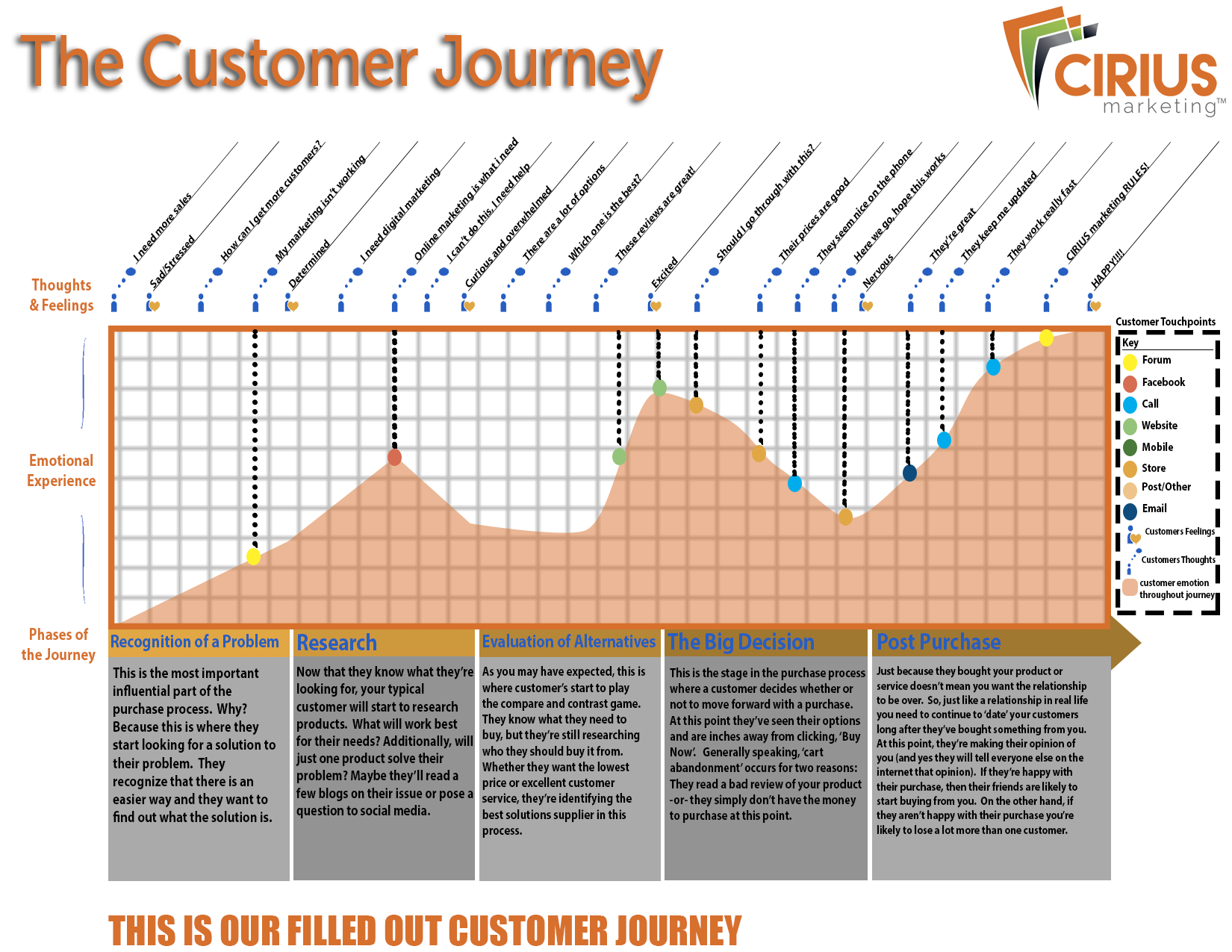Every business has heard it at some point – a customer journey is beneficial to your brand and your business.
Customer journeys are recommended for every business from insurance to technology sales.
Although many businesses understand the steps required to create a customer journey map, few understand why one is necessary.
Why You Need to Map Your Customer’s Journey
1.Creating a customer journey (and ultimately, using a map to lay it out) is beneficial for numerous reasons, but is especially helpful for businesses that have websites. The customer journey helps business performance overall – which ultimately brings greater traffic to your website.
2.According to the Harvard Business Review, a TV provider company found that over the course of its interactions with one customer, that customer’s satisfaction fell 40 percent. This is because, although many businesses consider customer service at every individual touchpoint, the overall picture – the customer “journey” – is much more important.
Businesses that consider every step in the customer’s interaction with the company and work to make that journey as streamlined as possible (by forming an overall vision of service and mapping out the journey) see a jump in customer satisfaction.
3.This improves business performance overall, and once businesses see a jump in profits, their websites receive much more traffic, further spreading the world and helping promote the business.
4.The website is important for more than just promotion – it can oftentimes be a crucial part of the customer journey itself.
Websites are those “touchpoints” that together make up a customer journey – often, customers will have to visit the website to find contact info, make a purchase, or research product or service options.
This means that the customer journey matters to your website because of the necessity of knowing what the overall picture looks like for your website – then, you can craft your website to the needs of your customers to meet the goals that you set in the journey.
5.Having a customer journey ultimately benefits the website because customers that use it as a part of that journey will have a greater reason to visit the website.
While on your site, they can discover other aspects of your business, such as online deals or promotions, further information, and social media updates.
Keep these considerations in mind when creating a customer journey, and consider how to integrate the customer journey into your website.
Whether through video, graphic or text formats, you can utilize your website and make sure the customer journey benefits your business.
All of these elements come together to create the customer experience and define the way your customers perceive your business.
In fact, I’ll do you one better. Here’s a sample customer journey map from Cirius Marketing:

Starting to see the bigger picture behind this? Go ahead and right click to save this image.
Need some help with that? We’ve created more journeys than we can count.
Our Customer Journey Map makes creating your customer journey fast and efficient.
Guess what? We’ll give it to you for free.
Quick Tips for Creating Your Customer Journey
If you’re a business that’s decided to create a customer journey map, you’ve made the right decision. Customer journey maps are visual or written records of the customer experience for each individual business, or even for each transaction within a business.
The goal of mapping the customer journey is to help both the customer and the business.
Customers can get a clearer idea of what the business intends to do for them, and businesses can set goals so that they know what to work towards when improving the customer experience.
Take a look at these 3 tips for mapping the customer journey, and get started today.
Avoid PowerPoint.
PowerPoint is limiting in that you can only display one main idea per slide; a true customer journey map should compare all aspects of the journey, from start to finish, side-by-side.
This allows the business (and the customer) to gain a comprehensive idea of the customer experience and seeing this “bigger picture” helps craft overall impressions and goals.
When creating a customer journey map with the aim of handing out to customers, try a brochure or flyer format; making it aesthetically pleasing will also add to your sense of professionalism.
Include separate phases.
Customer journey mapping should always divide the experience into discrete phases. These phases commonly include awareness (of the business or product), questioning, pricing, purchase, post-sales support, complaints, upgrades, and renewal of the original purchase. Include some or all of these phases, or try out some new ones unique to your business.
Each phase should include goals that you want the customer to have accomplished by the end – for example, “know what the product is and why it is better than the competition” – as well as an estimated timeframe for this goal to be accomplished in (will it take one phone call? ten?).
Specify “customer touchpoints”.
Each phase of the customer journey will have certain “touchpoints” where customers will interact with your company, whether through communicating with employees, reading a brochure or flyer, visiting your website, or interacting on social media.
Specifying these points will allow you to have a clear course of action to make the customer journey a reality – you need to release this commercial or make this phone call.
Do you want loyal customers that build your brand with you? Provide an experience they can count on.
Click Here to Download Our FREE Customer Journey Map Template
This awesome customer journey template includes detailed instructions and expert tips for mapping the perfect customer experience at every stage of their purchase process.
